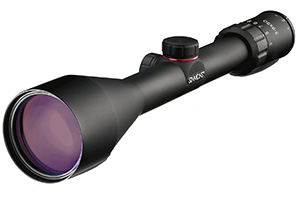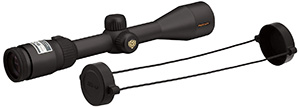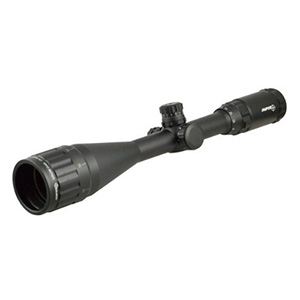Best Rifle Scopes For The Money – 2019 Top 5 Ranking
Once you’ve decided the time is ripe to get a new scope for your rifle, you need to make sure you are getting a scope that’s worth what you pay for it. After all, you want your hard-earned money to go towards something that’s going to improve your shooting, not test your patience. That’s where we come in, because we do the research for you and let you know which scopes are good and which fall flat. This page will explain what you should look for in a scope, but first, let’s take a look at our list of the top 5 best rifle scopes for the money:
Top 5 Picks:
| Model | Magnification | Eye Relief | Field of View @ 100 yards (min. / max. magnification) | Water/Fog Proof? |
|---|---|---|---|---|
Leupold VX-I Scope Check Today's Price | 2.4X - 6.7X | 3.5" | 46.2 ft. / 17.8 ft. Our Review | Yes |
Simmons 8-Point Truplex Scope Check Today's Price | 3X - 9X | 3.75" | 31.4 ft. / 10.5 ft. Our Review | Yes |
Bushnell Banner Illuminated Crossfire Check Today's Price | 4X - 16X | 3.3" | 22 ft. / 6 ft. Our Review | Yes |
Nikon Prostaff Check Today's Price | 3X - 9X | 3.6" | 33.8 ft. / 11.3 ft. Our Review | Yes |
Sniper® Illuminated Scope Set Check Today's Price | 4X - 16X | 3.3" | 22 ft. / 6 ft. Our Review | Yes |
Best Budget Rifle Scope:
If you’re on a slim budget, the Best Budget Model would have to be the Sniper 4–16x50mm riflescope. This scope provides magnification from 4X to 16X, and the picture is crystal clear without any hint of the yellowish tint that you usually find on Chinese-made optics. Considering the Sniper 4–16x50mm scope is priced at under $100, the scope is a fantastic deal that’s been test-fired on rifles up to .50 caliber.
Best Rifle Scope Overall:
If you don’t have a tight budget in mind, even our Best High End Model is a good value. The Leupold VX-I Rimfire Riflescope features stunning image clarity and resolution and rock-solid performance in all lighting conditions. The scope performed as well in our testing as you would expect a Leupold to perform, and it has proven itself to be our favorite scope, by far.
Okay, so how do we determine which scopes we are going to feature as our Top 5? Well, we examine in detail various characteristics when we review all of the scopes for this site, and the Top 5 are the top performers across all characteristics. Here is what you should be looking for.
How Big Is the Scope
One thing you definitely want to take into consideration is the size of the scope. While high-powered optics are, by nature, larger than lower powered scopes, you can find yourself taking things too far and ending up with a scope that makes your rifle difficult to handle. You should look at the size of the scope, how much room it requires on the mounting rail, and what the scope weighs. You should also take note of the length and diameter of the scope’s objective lens, so you know whether or not you need medium- or high-profile rings to mount the scope. In an ideal scope, you would find a perfect balance of size and weight, but you won’t always find that perfection when you’re in the market for high-powered optics good for several hundred yards.
How Powerful Is the Scope?
Next, decide how much magnification you need and how much magnification the scope you’re looking at offers. If you aren’t going to be hunting over more than a hundred yards or so, you probably don’t need more than a 4X or 6X scope, but if you want to shoot really far distances, like out to 300 or 400 yards, you’ll want a scope that magnifies the target at least 10X.
More than just the power of the magnification, though, you should pay attention to the quality of the magnification. It’s not good enough just to magnify the image and leave it blurry; the best rifle scopes will provide a crisp, clear image at maximum magnification, maybe even letting you make out the whiskers on a rabbit from 250 yards.
Quality of the Optics
Once you have an idea of how good the magnification is, you should look at the quality of the optics. If the optics are fully multi-coated, you are likely to get much better light transmission than if the optics are just multi-coated. You’ll also see better clarity of the image, and find the scope just flat out works better in the low light conditions that are often best for hunting. On the other hand, if all you do is target shoot, it might not matter so much whether the optics are fully multi-coated or just multi-coated.
The other thing to look for when you plan on using a scope for hunting (or for any conditions when the temperature might be cold) is a nitrogen-charged barrel. This is important, because regular air in a scope’s barrel will condense in cold weather, resulting in fogging on the inside and outside of your scope. Nitrogen is an inert gas and does not condense in cold temperatures, so a nitrogen-filled scope is fogproof. Some of the best scopes, particularly those made by Leupold, are filled with argon and krypton instead; this offers the same level of protection against condensation, and still results in a fogproof scope.
The last bit of the optics to look at is the reticle itself. Not all reticles are created equally, and some scopes have reticle lines that are so wide they make it difficult to get the pinpoint accuracy you want from more than 100 yards. Make sure the reticle lines are thin, no more than 2.5 MOA, or you’ll have trouble at the range and in the hunting field with long-range targets.
Light Gathering Capability
If you’re a hunter, you probably spend a lot of your time looking for prey in low-light conditions. After all, the early hours of dawn and the late evening hours just before and just after dusk are often the best time to find animals out and about. With this in mind, you want to choose a scope that has outstanding light gathering capabilities. You might also want to consider a scope with illuminated reticles, but make sure the illumination is not too bright! Another nice feature to look for is blackened lens edges; this prevents diffusion of light and the interference of ambient light, providing a better image with starker contrast and more efficient light transmission.
Field of View
Another thing to think about is the scope’s field of view, especially if you are hunting creatures that might move quickly. If your scope’s field of view is too narrow, you’ll find yourself struggling to find the creature and keep it bracketed. It’s only natural for the field of view to be restricted in a magnified image, but look for a scope that has the widest possible field of view at the magnification you want. Once again, if all you plan on doing with the scope is target-shoot at unmoving targets, this won’t be as important.
Ease of Mounting and Tips and Tricks for Mounting
Unless you are a gunsmith, you want a scope that will be easy to mount. Most of the scopes we review don’t come with rings, but some do, and you need to pay attention to whether or not rings are included and the quality of the included rings. You should also pay heed to advice we give as to needing high-profile rings, since some scopes have such wide objective lenses that the lens will rub the barrel if it’s mounted with standard 1″ rings.
Ease of Sighting In
Once you’ve got the scope mounted, you need to sight it in. Look for a scope that sights in easily, holds zero for a long time, and provides clear instructions about ranges for the reticle and any range compensation markers. Sometimes, a scope will have the directional markings reverse of the norm, and you should note that when you’re reading reviews on scopes. Nothing’s more frustrating than to try sighting in a scope just to find out the markings are backwards and you didn’t know it beforehand!
Durability
Lastly, you want to make sure the scope is durable enough for your gun and your shooting habits. You should look for a scope with aircraft-grade aluminum for the chassis, and rubber coating is an added bonus to protect the scope against bumps and scrapes. You should also take note of whether or not the scope’s lenses are O-ring sealed for waterproofing, and what level of fogproofing and shockproofing the scope offers. Transporting your gun to the range or to the hunting grounds can often put a lot of wear and tear on the scope, and you’ll want to know whether it can withstand a little bit of abuse.
Summary
At the end of every review, we’ll wrap up by telling you the best and worst features of the scope. Pay special attention to this section, because this is also where we will tell you whether or not we can recommend that particular scope.
With some research and forethought, you’ll find it relatively painless to get a good quality scope, often at a price that might surprise you.








